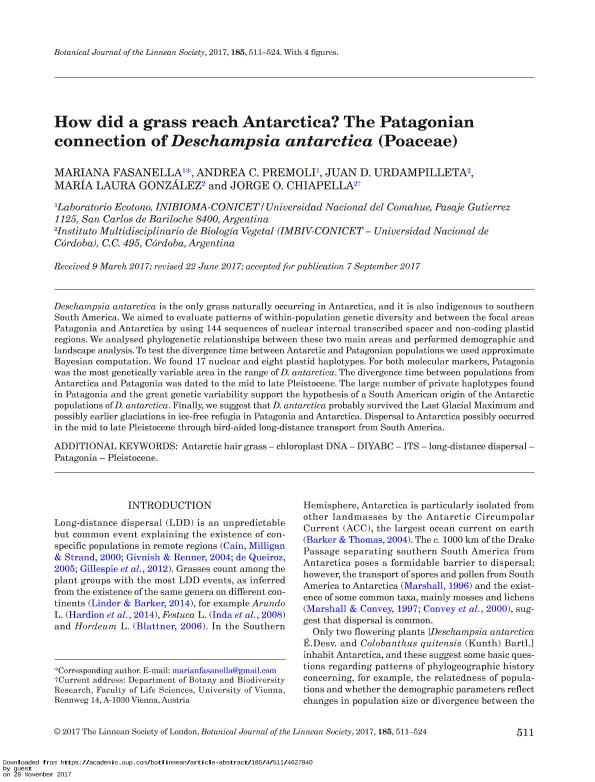Mostrar el registro sencillo del ítem
dc.contributor.author
Fasanella, Mariana

dc.contributor.author
Premoli Il'grande, Andrea Cecilia

dc.contributor.author
Urdampilleta, Juan Domingo

dc.contributor.author
González, María Laura

dc.contributor.author
Chiapella, Jorge Oscar

dc.date.available
2018-01-19T21:37:54Z
dc.date.issued
2017-11
dc.identifier.citation
Fasanella, Mariana; Premoli Il'grande, Andrea Cecilia; Urdampilleta, Juan Domingo; González, María Laura; Chiapella, Jorge Oscar; How did a grass reach Antarctica? The Patagonian connection of Deschampsia antarctica (Poaceae); Oxford University Press; Botanical Journal of The Linnean Society; 185; 4; 11-2017; 511-524
dc.identifier.issn
0024-4074
dc.identifier.uri
http://hdl.handle.net/11336/34038
dc.description.abstract
Deschampsia antarctica is the only grass naturally occurring in Antarctica, and it is also indigenous to southern South America. We aimed to evaluate patterns of within-population genetic diversity and between the focal areas Patagonia and Antarctica by using 144 sequences of nuclear internal transcribed spacer and non-coding plastid regions. We analysed phylogenetic relationships between these two main areas and performed demographic and landscape analysis. To test the divergence time between Antarctic and Patagonian populations we used approximate Bayesian computation. We found 17 nuclear and eight plastid haplotypes. For both molecular markers, Patagonia was the most genetically variable area in the range of D. antarctica. The divergence time between populations from Antarctica and Patagonia was dated to the mid to late Pleistocene. The large number of private haplotypes found in Patagonia and the great genetic variability support the hypothesis of a South American origin of the Antarctic populations of D. antarctica. Finally, we suggest that D. antarctica probably survived the Last Glacial Maximum and possibly earlier glaciations in ice-free refugia in Patagonia and Antarctica. Dispersal to Antarctica possibly occurred in the mid to late Pleistocene through bird-aided long-distance transport from South America.
dc.format
application/pdf
dc.language.iso
eng
dc.publisher
Oxford University Press

dc.rights
info:eu-repo/semantics/openAccess
dc.rights.uri
https://creativecommons.org/licenses/by-nc-sa/2.5/ar/
dc.subject
Antarctic Hairgrass
dc.subject
Chloroplast Dna
dc.subject
Diyabc
dc.subject
Its
dc.subject
Long Distance Dispersal
dc.subject
Patagonia
dc.subject
Pleistocene
dc.subject.classification
Otras Ciencias Biológicas

dc.subject.classification
Ciencias Biológicas

dc.subject.classification
CIENCIAS NATURALES Y EXACTAS

dc.title
How did a grass reach Antarctica? The Patagonian connection of Deschampsia antarctica (Poaceae)
dc.type
info:eu-repo/semantics/article
dc.type
info:ar-repo/semantics/artículo
dc.type
info:eu-repo/semantics/publishedVersion
dc.date.updated
2018-01-12T19:28:39Z
dc.journal.volume
185
dc.journal.number
4
dc.journal.pagination
511-524
dc.journal.pais
Reino Unido

dc.description.fil
Fil: Fasanella, Mariana. Consejo Nacional de Investigaciones Científicas y Técnicas. Centro Científico Tecnológico Conicet - Patagonia Norte. Instituto de Investigaciones en Biodiversidad y Medioambiente. Universidad Nacional del Comahue. Centro Regional Universidad Bariloche. Instituto de Investigaciones en Biodiversidad y Medioambiente; Argentina
dc.description.fil
Fil: Premoli Il'grande, Andrea Cecilia. Consejo Nacional de Investigaciones Científicas y Técnicas. Centro Científico Tecnológico Conicet - Patagonia Norte. Instituto de Investigaciones en Biodiversidad y Medioambiente. Universidad Nacional del Comahue. Centro Regional Universidad Bariloche. Instituto de Investigaciones en Biodiversidad y Medioambiente; Argentina
dc.description.fil
Fil: Urdampilleta, Juan Domingo. Consejo Nacional de Investigaciones Científicas y Técnicas. Centro Científico Tecnológico Conicet - Córdoba. Instituto Multidisciplinario de Biología Vegetal. Universidad Nacional de Córdoba. Facultad de Ciencias Exactas Físicas y Naturales. Instituto Multidisciplinario de Biología Vegetal; Argentina
dc.description.fil
Fil: González, María Laura. Consejo Nacional de Investigaciones Científicas y Técnicas. Centro Científico Tecnológico Conicet - Córdoba. Instituto Multidisciplinario de Biología Vegetal. Universidad Nacional de Córdoba. Facultad de Ciencias Exactas Físicas y Naturales. Instituto Multidisciplinario de Biología Vegetal; Argentina
dc.description.fil
Fil: Chiapella, Jorge Oscar. Consejo Nacional de Investigaciones Científicas y Técnicas. Centro Científico Tecnológico Conicet - Córdoba. Instituto Multidisciplinario de Biología Vegetal. Universidad Nacional de Córdoba. Facultad de Ciencias Exactas Físicas y Naturales. Instituto Multidisciplinario de Biología Vegetal; Argentina
dc.journal.title
Botanical Journal of The Linnean Society

dc.relation.alternativeid
info:eu-repo/semantics/altIdentifier/doi/http://dx.doi.org/10.1093/botlinnean/box070
dc.relation.alternativeid
info:eu-repo/semantics/altIdentifier/url/https://academic.oup.com/botlinnean/article-abstract/185/4/511/4627840
Archivos asociados
